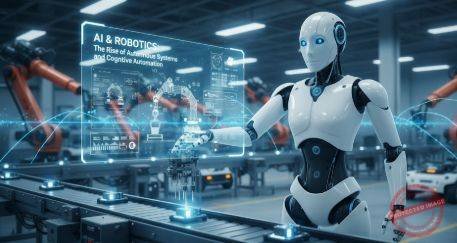How Artificial Intelligence Is Giving Robots the Power to Perceive, Learn, and Decide—Redefining the Boundaries of Automation.
From Automation to Autonomy
For decades, industrial robots have followed one fundamental rule: repeat preprogrammed actions flawlessly. But in today’s intelligent era, that’s no longer enough.
The integration of Artificial Intelligence (AI) has transformed robots from programmable machines into adaptive systems capable of perception, reasoning, and decision-making.
This fusion—known as cognitive automation—is unlocking a new generation of autonomous robots that don’t just do tasks; they understand them. Whether it’s a warehouse robot rerouting around an obstacle or a drone analyzing terrain in real time, AI is giving machines the ability to think for themselves.
The Architecture of Autonomous Systems
Autonomy in robotics is built upon a layered intelligence stack that mirrors human cognition.
-
Perception: Sensors, cameras, LiDAR, and radar provide environmental awareness.
-
Computation: AI algorithms process data to interpret the world around them.
-
Decision-Making: Machine learning models enable dynamic choices and planning.
-
Action: Control systems execute precise movement and manipulation.
These layers allow robots to move, adapt, and react autonomously in unstructured environments—from manufacturing floors to hospitals and beyond.
Cognitive Automation: When Robots Learn to Think
Cognitive automation goes beyond task execution—it combines AI, machine learning, and natural language processing to enable human-like reasoning.
Examples include:
-
Self-optimizing robots that improve efficiency through continuous feedback.
-
Conversational robots that interpret and respond to voice commands.
-
Autonomous vehicles that predict driver behavior and road conditions.
-
Industrial cobots that learn workflows by watching human operators.
This new era of robotics represents a shift from programming to teaching, where robots learn through demonstration, simulation, and experience.
AI in Action: Real-World Applications
Across industries, AI-driven robots are redefining performance standards:
-
Manufacturing: AI-powered inspection robots detect microscopic defects.
-
Logistics: Autonomous mobile robots (AMRs) navigate warehouses dynamically.
-
Agriculture: Drones and harvest bots monitor crops and optimize irrigation.
-
Healthcare: AI-assisted surgical robots adapt precision based on patient anatomy.
-
Exploration: Space rovers and underwater drones analyze and map uncharted environments.
These intelligent machines extend human reach—exploring where it’s dangerous, performing where it’s demanding, and learning where it’s complex.
Edge AI: Real-Time Intelligence at the Source
To operate independently, autonomous robots must process data instantly, without relying on remote cloud servers. Edge AI makes this possible.
By embedding intelligence directly into the robot’s hardware, edge computing enables:
-
Ultra-low latency for split-second decisions.
-
Enhanced privacy by keeping sensitive data local.
-
Offline operation in remote or hazardous environments.
This decentralized intelligence is turning robots into self-reliant systems, capable of analyzing and acting in real time.
Human–Robot Collaboration in Autonomous Workflows
Autonomous systems are not replacing humans—they’re extending human capability.
In smart factories, AI-driven robots handle precision tasks while humans manage strategy and oversight. In logistics, fleets of autonomous vehicles collaborate with human coordinators for optimal efficiency.
The most effective automation strategies combine machine precision with human judgment, forming hybrid systems that achieve levels of performance neither could reach alone.
Ethics and Accountability in AI-Driven Robotics
As robots gain decision-making power, ethical and regulatory questions intensify:
-
Who is responsible when an autonomous system makes an error?
-
How do we ensure AI decisions are transparent and unbiased?
-
What boundaries should exist between autonomy and human control?
To address these challenges, global initiatives such as the IEEE Global Initiative on Ethical AI, OECD AI Principles, and EU AI Act are shaping frameworks for responsible autonomy—balancing innovation with accountability.
Closing Thoughts and Looking Forward
The convergence of AI and robotics is ushering in a world of machines that can perceive, reason, and adapt. This transformation redefines automation—not as a replacement for human effort, but as an amplifier of human intelligence.
The future belongs to autonomous systems that learn continually, collaborate intelligently, and act ethically. As robots grow more cognitive, humanity must grow more strategic—guiding their evolution toward outcomes that serve progress, safety, and purpose.
The age of intelligent machines has begun—and it’s learning fast.
References
-
“AI and the Future of Robotics” – World Economic Forum
https://www.weforum.org/agenda/2024/09/ai-and-the-future-of-robotics -
“Cognitive Automation and the Evolution of Smart Robotics” – McKinsey & Company
https://www.mckinsey.com/industries/technology/our-insights/cognitive-automation-and-smart-robotics -
“Edge AI and Real-Time Decision Systems” – MIT Technology Review
https://www.technologyreview.com/2024/10/14/edge-ai-and-real-time-decision-systems -
“Ethical and Regulatory Frameworks for Autonomous Systems” – Deloitte Insights
https://www.deloitte.com/insights/ethical-frameworks-for-autonomous-systems -
“How AI Is Reshaping Robotics and Industry 5.0” – Forbes Tech Council
https://www.forbes.com/sites/forbestechcouncil/2024/09/25/how-ai-is-reshaping-robotics-and-industry-5-0
Author: Serge Boudreaux – AI Hardware Technologies, Montreal, Quebec
Co-Editor: Peter Jonathan Wilcheck – Miami, Florida
#AI #Robotics #Automation #EdgeAI #CognitiveAutomation #Industry50 #MachineLearning #AutonomousSystems #DigitalTransformation #TechNews
Post Disclaimer
The information provided in our posts or blogs are for educational and informative purposes only. We do not guarantee the accuracy, completeness or suitability of the information. We do not provide financial or investment advice. Readers should always seek professional advice before making any financial or investment decisions based on the information provided in our content. We will not be held responsible for any losses, damages or consequences that may arise from relying on the information provided in our content.



